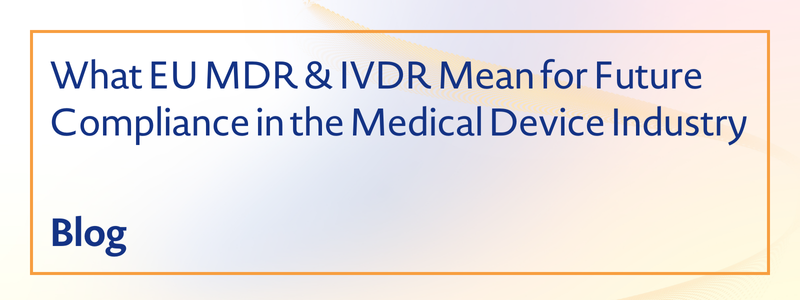What EU MDR & IVDR Mean for Future Compliance in the Medical Device Industry

What EU MDR & IVDR Mean for Future Compliance in the Medical Device Industry

(Source: Christian Lue on Unsplash)
Brought to you by WBR Insights.
The European Union's (EU) Medical Device Regulation (2017/745) and In Vitro Diagnostic Regulation (2017/746) set standards and oversight requirements for manufacturers of medical devices and in vitro diagnostic solutions that intend to distribute their products in the EU.
They are a much-needed replacement for decades-old regulations. However, they affect healthcare technology organizations within and outside of the EU. They have also brought some significant challenges and opportunities to these companies' operations.
Medical device companies have been preparing in anticipation of higher costs and longer timeframes for developing new products. But they have also been looking beyond these regulations, developing strategies that will allow them to thrive in the new and rapidly changing regulatory environment.
Here's what the EU MDR and IVDR mean for medical device manufacturers moving forward, and what changes to manufacturers' regulatory strategies mean for compliance in the future.
Organizations Have Prepared for EU MDR & IVDR Despite Challenges
Because these regulations were first launched in 2017, medical device manufacturers have had ample time to prepare for the EU MDR and IVDR regulations. And although May 26th, 2020 was the original date these regulations were set to go into effect, the COVID-19 pandemic warranted an extension. The regulations will now go into effect on May 26th, 2021.

According to a recent study by SDL and WBR Insights entitled "EU MDR & IVDR and Their Impact on the Medical Device Industry," most medical device manufacturers and their field service teams are prepared or mostly prepared for both of these regulations—60% of the respondents reported they were "positive" or better in their preparedness for EU MDR, while 69% of the respondents reported they were "positive" or better in their preparedness for EU IVDR.
Still, organizations were dealing with significant challenges to meet the requirements of these regulations at the time of the study. It's important to take note of these challenges, as they may come into play when further regulations are released by the EU and elsewhere.

Most of the respondents cited clinical data requirements (61%), software requirements (61%), and marketing requirements (51%) as their key challenges with compliance. The regulations set heightened standards for the clinical testing requirements and reclassified some devices, which will likely increase certification costs.
But the regulations also set strict requirements for the evaluation of medical devices by "notified bodies" (NBs)—organizations that assess the conformity of medical products to technical requirements set by EU member states. The regulations also emphasize post-market surveillance. In other words, medical device manufacturers must proactively monitor the performance of devices after they are sold and deployed—sometimes implanted within patients—so that they can be recertified later.
Both initiatives make it imperative that medical device manufacturers operating in the EU have full visibility into any medical devices in the field, as they must be able to report effectively on their performance. This requires the utilization of reporting systems, either through the implementation of IoT sensors that can collect field data or through reporting systems in which patients and clinicians can report adverse effects and other concerns.
These types of standards are important for ensuring the efficacy of medical devices and the safety of patients, but they also require significant investments from medical device companies. Thankfully, most organizations have already initiated programs to comply with these regulations and to meet surveillance requirements in the future.
Automation Holds Promise for Effective Compliance
After years of preparation, medical device companies have gained insights into the future of compliance.
Researchers from the "EU MDR & IVDR" report asked respondents to share their most important lessons. If there is one approach that sticks out in their responses, it's the adoption of technology-enabled workflows that can deliver continuous support for compliance with end-to-end regulations—particularly through automation.
"There is continuous guidance required for compliance and regulatory policies like these and with the technology available," said a respondent. "We need automated compliance more than ever."
Another respondent said, "We need more of an automated system that can maneuver this ocean even in the tightest of locations."
The automation deployments medical manufacturing organizations make now won't just affect their ability to comply with these two regulations. They will also play a continuing role in how quickly and effectively they can meet compliance standards in years to come. Introducing automation into the process is a good first step, but an end-to-end solution that spans the manufacturing organization and the supply chain is also necessary.
Get Ahead of the Curve on Regulation
Medical device companies have made significant breakthroughs in recent years, bringing an entirely new generation of life-saving tools to the market. Organizations should anticipate additional regulatory compliance measures on the horizon. Medical device regulations are an important part of ensuring patients have access to safe and effective care, but they do come with costs and challenges, some of which can be abated through the strategic deployment of new processes and technologies.
Regulatory compliance is set to be a hot topic at the next Field Service Medical Virtual Event, happening online from May 4th to May 5th. Sign up for free to hear from industry leaders in customer success, service, and support.